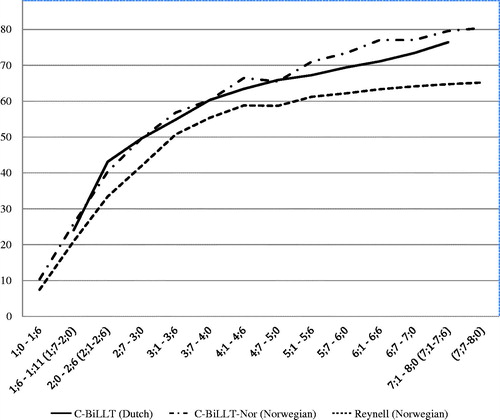Figures & data
Table 1. Sections of the Computerized Part of the C-BiLLT, including Description of Content and Examples (Geytenbeek et al., Citation2014).
Table 2. Sequence of tests administered to the three age groups and test orders (A and B) for the two oldest groups.
Table 3. Minimum, maximum, mean (M), standard deviation (SD), range of scores within one SD from age mean, skewness, and kurtosis of raw scores on the C-BiLLT-Nor.
Table 4. Mean (M), standard deviation (SD), skewness and Kurtosis for z-scores on tests of verbal comprehension and non-verbal reasoning.
Table 5. Pearson correlations (n) of raw scores from the tests C-BiLLT-Nor, Reynell, TROG-2, Word Recognition, Block Design, and Raven.
Figure 1. Comparison of raw scores (y-axis) in different age groups (x-axis) across tests. These include the Dutch version of C-BILLT (maximum score of 88, from Geytenbeek et al., Citation2014), the Norwegian C-BiLLT-Nor (maximum score of 88) and language comprehension raw scores on the Norwegian version of Reynell Developmental Language Scales (maximum score of 67).

Table 6. Differences in mean (M) raw scores on the C-BiLLT-Nor between whole-year groups.
Table 7. Pattern matrix from the exploratory factor analysis.
Table 8. Mean (M) raw scores on C-BiLLT-Nor for participants using finger pointing and gaze pointing at time of first assessment (test) and second assessment (retest).
